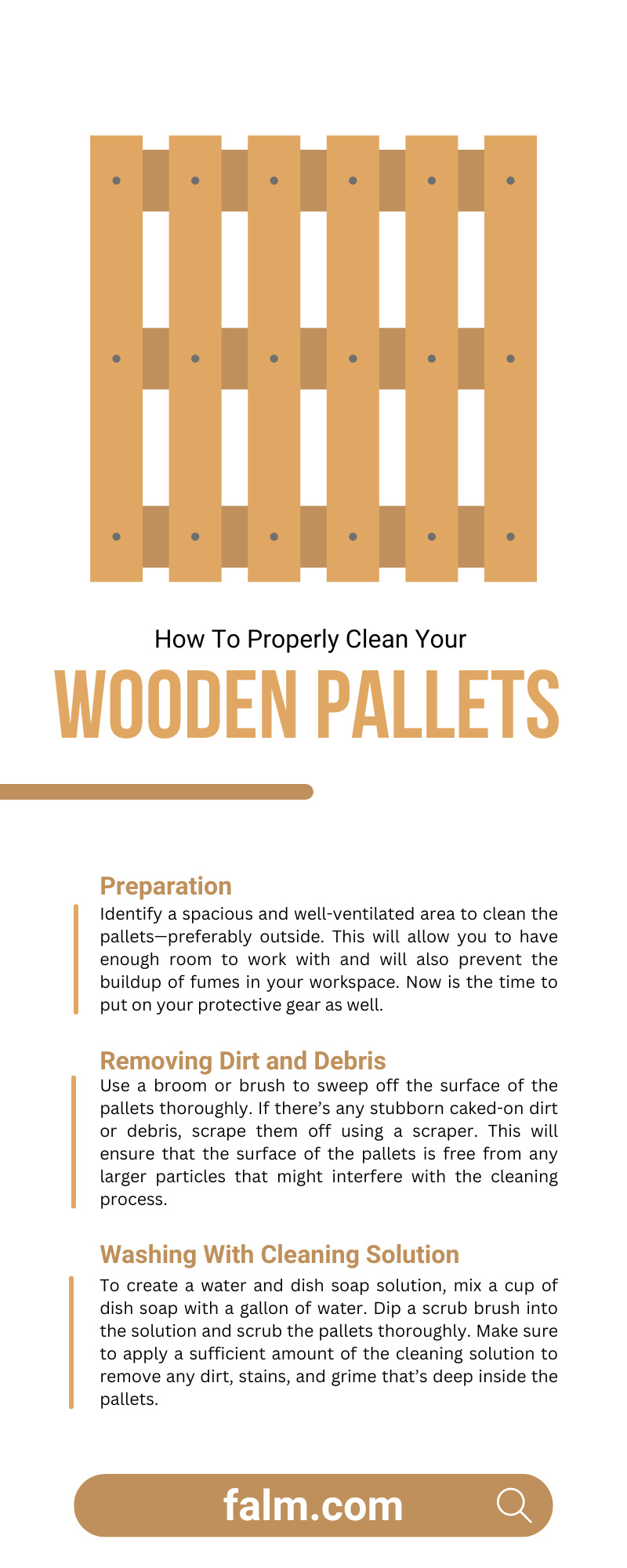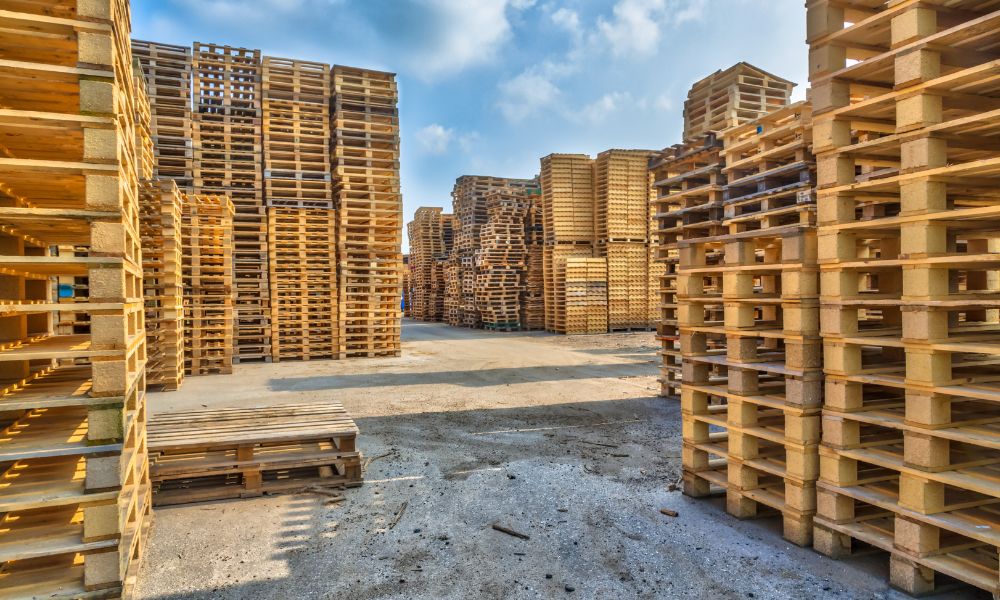Wooden pallets are commonly used in different industries to ensure safe and efficient movement and transportation of goods. They are durable and versatile, making them perfect for stacking and transporting heavy loads.
However, wooden pallets are often susceptible to dirt, dust, and grime when used over the course of many years, which can compromise their quality and safety. Knowing how to properly clean your wooden pallets is essential for maintaining them. Here’s what you should know about this cleaning process.
Why Clean Your Wooden Pallets?
Before we dive into the process, though, we need to talk about why cleaning your pallets is so important. First off, washing your wooden pallets is essential to maintain good sanitation by preventing the spread of germs or bacteria. Since these pallets transport all sorts of products, including food, medicines, and other sensitive items, you must keep them clean. If you don’t, they could potentially contaminate the products they are carrying.
Additionally, wooden pallets that you don’t clean can become a breeding ground for pests, including insects and possibly rodents. This can damage the pallets and the products they carry, leading to financial losses for businesses. Plus, these pests will eventually degrade the quality of your pallets, causing you to need replacements sooner.
Tools and Materials Required
Now that you understand why, you need to know which tools and other materials you’ll need to wash your pallets effectively. Without the right equipment, your pallets might not get as clean as they need to be to prevent the previously mentioned problems. Here’s a list of items you will need:
- Protective gear, such as gloves, safety goggles, and a dust mask
- A broom or brush to remove debris and dirt
- A hose or pressure washer for rinsing your pallets
- A bucket and a stiff-bristled brush for scrubbing your pallets
- An all-purpose cleaner, diluted bleach, or vinegar solution
- A sponge or cloth for wiping down your pallets
Cleaning Your Wooden Pallets
With all the necessary gear in hand, it’s time to start washing your pallets. This process can vary a bit depending on the level of dirt and grime on the pallets. Even the type of pallets you own might slightly change the cleaning process. For example, if you have molded pallets, the drying process won’t be as difficult since the water won’t be able to seep in as deeply. Regardless of how you decide to clean your wood pallets, here are the basic steps you can follow to achieve your end goal.
Preparation
Before you begin cleaning your wooden pallets, it’s essential to take some preparatory measures to ensure a safe and effective cleaning process. Identify a spacious and well-ventilated area to clean the pallets—preferably outside. This will allow you to have enough room to work with and will also prevent the buildup of fumes in your workspace. Now is the time to put on your protective gear as well.
Removing Dirt and Debris
The first step in cleaning wooden pallets is to remove any loose dirt, dust, and debris that might have accumulated on them. Use a broom or brush to sweep off the surface of the pallets thoroughly. If there’s any stubborn caked-on dirt or debris, scrape them off using a scraper. This will ensure that the surface of the pallets is free from any larger particles that might interfere with the cleaning process.
Washing With Cleaning Solution
After removing the loose dirt and debris, you should create a cleaning solution to wash the pallets. There are different cleaning solutions that you can use for this process, depending on your preferences. You can use a mixture of water and dish soap, bleach and water, or a vinegar and water solution.
To create a water and dish soap solution, mix a cup of dish soap with a gallon of water. Dip a scrub brush into the solution and scrub the pallets thoroughly. Make sure to apply a sufficient amount of the cleaning solution to remove any dirt, stains, and grime that’s deep inside the pallets.
If you’re using a bleach solution, mix a cup of bleach with five gallons of water. For a vinegar and water solution, mix a cup of vinegar with a gallon of water. For both of these methods, you’ll apply the solution to the pallets using the same method as above. After applying your cleaning solution of choice, rinse the pallets thoroughly with a pressure washer or a garden hose. This will help remove any remaining dirt and cleaning solution.
Drying
After you’ve finished washing and rinsing, allow them to dry thoroughly. Sun-drying is the best method to ensure the pallets dry completely, as it also helps remove any remaining moisture that might have accumulated during the cleaning process. If it’s not sunny outside, place the pallets in a place with good ventilation and ensure they are not touching each other. Use a fan to blow air over the pallets to speed up the drying process.
Sanding
Once the pallets are dry, you can sand them to give them a smoother and cleaner finish. Use a fine-grit sandpaper to smooth out the surface of the pallets gently. Sanding the pallets also helps remove any rough edges and splinters that may have formed on the surface of the wood during the washing process.
Storing Your Wooden Pallets
Once you’ve finished cleaning your pallets, you need to make sure you store them away properly when not in use. Not only will this help keep your pallets in better condition, but it’ll help ensure they stay clean and in good condition for longer, precluding the need for more frequent washing.
Check out the following storage strategies to help maintain good pallet condition.
Avoid Excessive Moisture
You should store your unused wooden pallets in a dry area. This will help them avoid warping or rotting over longer periods of time. Plus, the lack of moisture will make them less likely to get dirty. You can also place pallets on pallet racking systems to keep them off the ground since this area tends to have more moisture buildup.
Keep Pallets Stacked Neatly
Storing pallets in a disorganized manner leads to unwanted stress on them. Stress can lead to cracks that will more easily accumulate dirt. Stacking pallets evenly, with no overhang, ensures there’s no excess force put on the bottom pallets.
Regularly Inspect Your Pallets
If you haven’t used some of your pallets in a while, be sure to look them over every few months or so. While this won’t stop them from getting dirty, it’ll help you evaluate if they’re in usable condition. If they aren’t, you can set up a proper time for their next washing.


